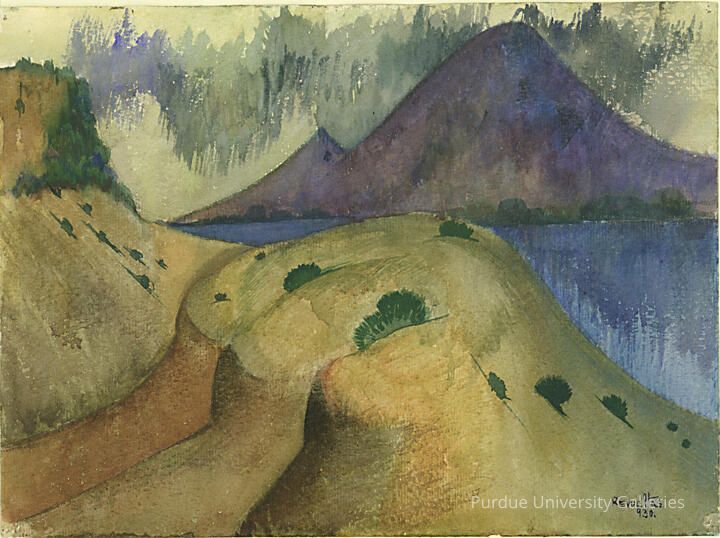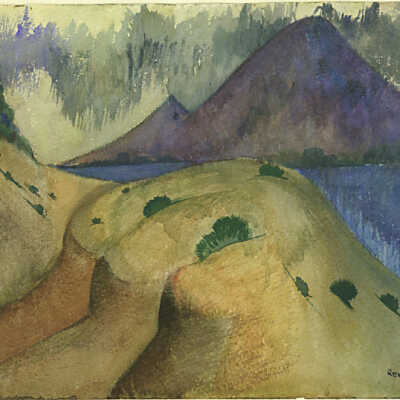Label Type
Cultural/Historical ContextLabel Type
Cultural/Historical ContextLabel
Born in northern Mexico, Fermin Revueltas studied at St. Edward's College in Austin, Texas, and the Art Institute of Chicago, Illinois, during the Mexican Revolution, but returned to Mexico in 1920. He was a part of the original muralist movement, with mural commissions alongside Diego Rivera and David Alfaro Siqueiros.
Much of Revueltas's subject matter reflects ideals of returning to the land and shows his deep attachment to the beauty of the natural landscape. Revueltas died at the age of 34.
Nacido en el norte de México, Fermin Revueltas estudió en St. Edward's College en Austin, Texas y en Art Institute of Chicago, Illinois durante la Revolución Mexicana pero regresó a México en 1920. Formó parte del movimiento muralista original, con murales comisionados junto a Diego Rivera y David Alfaro Siquieros.
Gran parte de los temas de Revueltas' refleja los ideas de regresar a la tierra y muestra su profundo apego a la belleza del paisaje natural. Reveultas murió a los 34 años.Label Type
Cultural/Historical ContextLabel
"Fermin Revueltas joined the ranks of fellow Mexican muralists such as Diego Rivera and Jose Clemente Orozco at a time of civil and artistic upheaval in Mexico. His life, tragically short, and career span a tumultuous period of political unrest, beginning with the onset of the Mexican Revolution in 1910 during his childhood and continuing through the various regimes of Francisco Madero, Victoriano Huerta, and Venustiano Carranza. His style reflects the influence of his contemporaries, the subject matter pulling from the work of Dr. Atl – the forerunner of Mexican Modernity – and his students, namely David Alfaro Siqueiros. This 1930 piece, an untitled landscape in watercolor, steps away from the idea of public art as embodied by the muralist work he shares in common with his artistic compatriots and focuses instead on the meaningful, personal art integral to the revolution and doctrine of these artists – a singular, one-of-a-kind piece in a simple style incorporating scenes of the indigenous landscape that is purely Mexican and Modern.
The struggle to try to create a style and identity on par with Modernity, but not to the point of pure imitation was a central key to the artistic revolution in Mexico and a main concern of the artists working to achieve this goal. Artists such as Dr. Atl, his students, and, subsequently, Revueltas sought to retain an intrinsically Mexican identity and heritage but also become Modern. This landscape by Revueltas works on the same level as similar pieces by Siqueiros and Dr. Atl – portraying the natural Mexican landscape in a primitive style, Impressionist in application of paint and reflective of French Japonisme in flat, planar layering. The European influence of color and light is second to the symbolic nature of the visual narrative, a focus on the landscape itself and its relevance to the message of these artists. Unlike the dark volcanoes presented by Siqueiros some years later or the violent eruptions in such influential works as Dr. Atl’s landscapes, Revueltas focuses instead on the peaceful, bright, curving nature of the Mexican countryside. The foreground is completely dominated by a rounded hillock, dotted with green shrubbery; the edges are carefully rounded and shaded in rich browns fading to golden yellows and mossy greens. The serenity of the soft frontal plane extends to the leftmost corner, up a steep cliff face with still more representation of vegetation and soft blending. The middle and background are devoted to calming blue and deep purple hues with quicker, more active brushstrokes indicative of a fervent speed – pointing again to an Impressionist influence. The golden plateau of the foreground meeting the darker roots of a gently rising mountain showcases a softer side of the Mexican land, a nod to the Romantic sublimity and reverence for nature with an intrinsically native Mexican scene.
Revueltas’s view of the Mexican landscape alludes to the Mexican identity and the return to pre-Columbian ideals in attempting to reconnect with this identity – a return to the land. His peaceful vision and style is a reflection of his own identity: a young, Mexican-born artist coming on to the artistic scene already established by revolutionaries disillusioned by ravaging war, attempting to reconnect with the country and its people.
Jordan Russell
"
